We may earn revenue from the products available on this page and participate in affiliate programs. Learn More ›
A healthy blaze in a wood-burning fireplace or stove adds ambience to cold winter nights, warms a room during a power outage, and could even help lower your heating bills. Some woods burn warmer and cleaner than others, however, and choosing the wrong wood could leave you with a smoky mess. Before stocking up on firewood for the season, get our best advice purchasing wood that will improve the efficiency and safety of your fires.
Selecting the Right Firewood
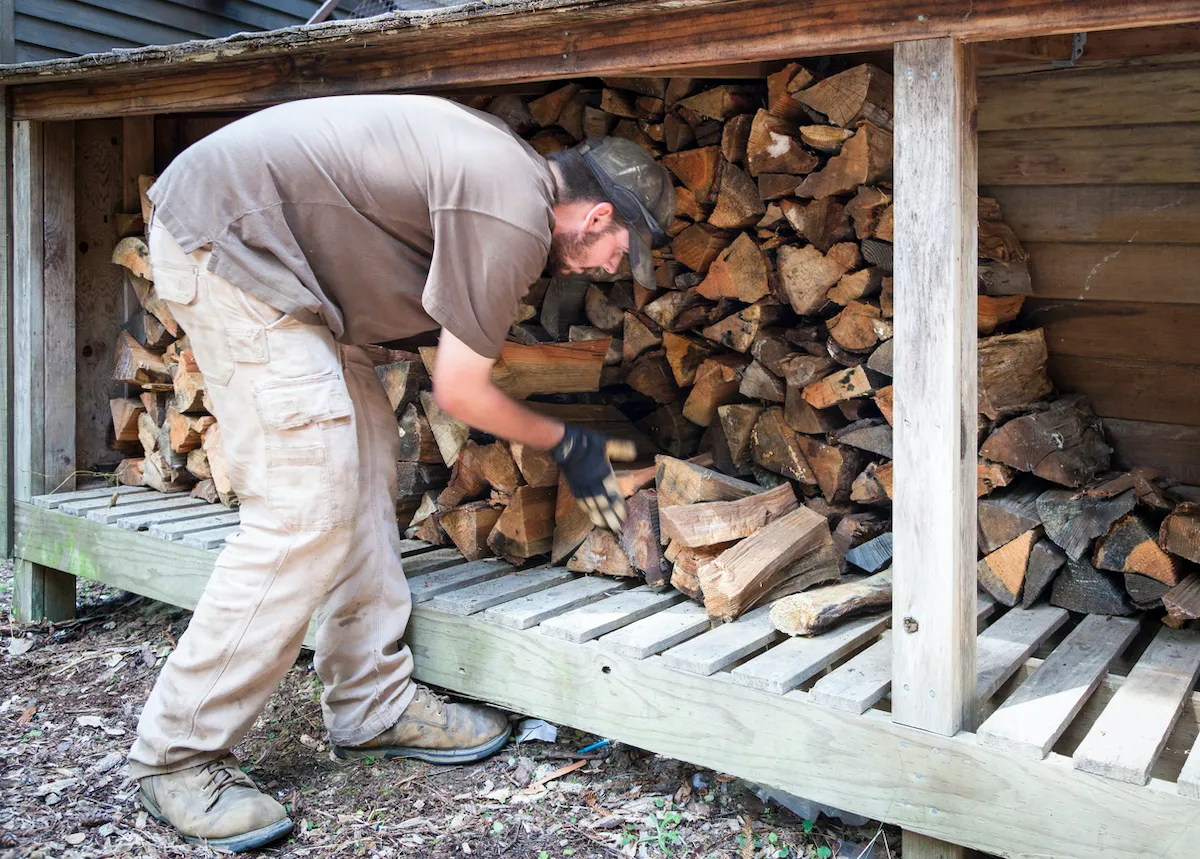
Choosing the best firewood to burn in your home fireplace comes down to wood type and factors like its heat output, its dryness, its source, and, of course, cost. When you see signs for firewood for sale that are accompanied by terms like “kiln dried,” “softwood” and “seasoned wood,” what does it all mean? Here are the kinds of firewood you want—and don’t want.
Hard vs. Soft Firewood
In most cases, hardwood from broadleaf trees produces more heat energy than softwood from conifers. Hardwoods such as oak and beech are dense, so when seasoned properly they’ll burn longer and with less smoke than softwoods. Hardwoods also produce hot coals (a characteristic known as coaling quality), which give off radiant heat for a longer period than softwoods, which quickly burn down to ash. Birch, cherry, maple, and walnut are a few more examples of hardwoods.
Softwoods typically include evergreens like pine, cedar, and juniper. They season faster than hardwoods and are generally cheaper than hardwoods. Although they can cost less at the time of purchase, a cord of softwood usually provides less burn time than a cord of hardwood.
Green Wood vs. Seasoned Wood
Green wood is freshly cut wood that has not been seasoned—in other words, it’s wood that hasn’t been given time to dry out. Wood’s moisture content affects both how long it takes to dry and how quickly and cleanly it burns. Since green wood contains up to 50 percent more moisture than seasoned wood, it will produce less heat and a lot more smoke and creosote buildup. In addition, wood that is not properly seasoned can take longer to combust.
The moisture in green wood reacts with creosote to form toxic acids that can irritate the eyes, nose, and throat and corrode the chimney. Well-seasoned wood, which is wood that has a moisture content below 20 percent, is the best wood for burning in your fireplace or wood stove.
Local vs. Imported Wood
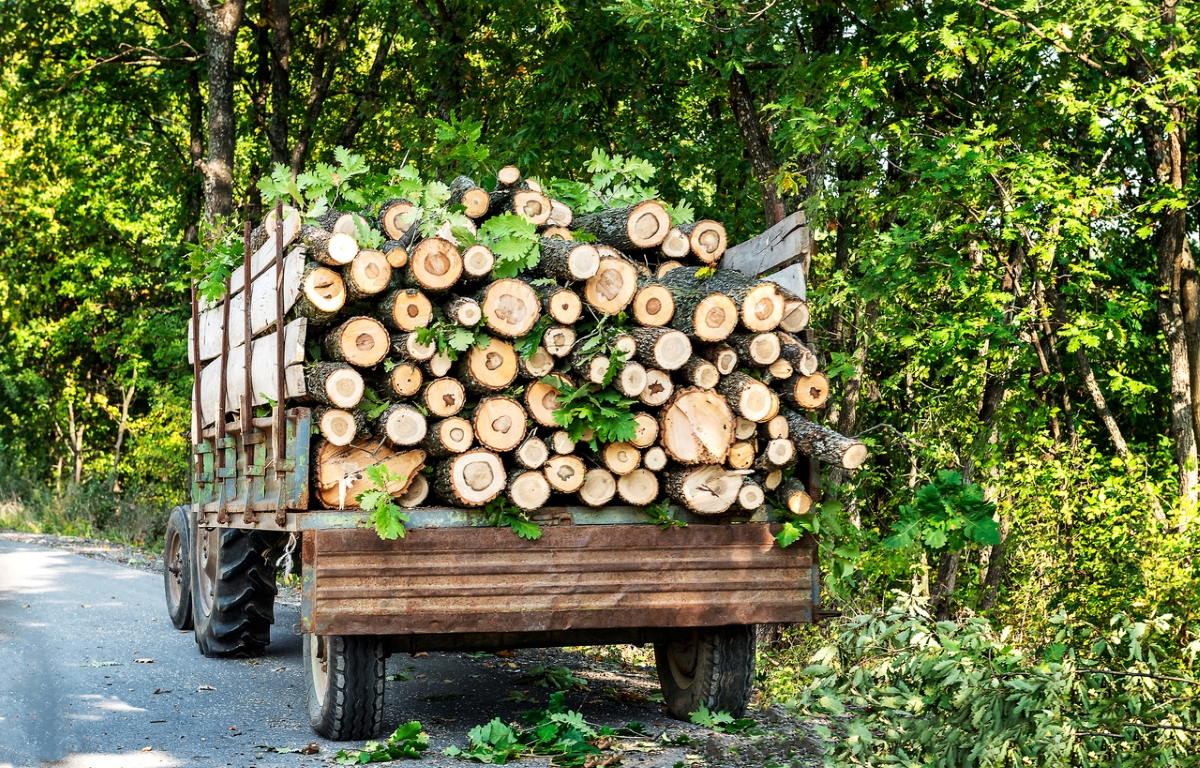
No matter which type of wood appeals to you the most, try to source it locally. It’s not just a matter of budget or sustainability: The insects that might tag along with wood from another state or region can be a big problem. Native trees know how to fight native pests, but when unfamiliar insects show up for the first time, native trees can’t defend themselves, which means that once those bugs settle into their new home, they can begin killing off trees in forests and yards.
According to Don’t Move Firewood, a campaign in partnership with The Nature Conservancy, moving firewood around the country can pose a big threat to trees and forests. Just as non-native plants can become invasive when moved to a new location, parasites and bugs that hitch rides on fireplace logs can threaten local ecosystems.
Importing firewood can have dire consequences for native species. The State of Minnesota, for example, warns that the extremely destructive emerald ash borer can travel on firewood, putting the at risk the nearly 1 billion ash trees in the state’s forests as well as the 2.7 million in the cities. Together with gypsy moths, another common firewood hitchhiker, ash borers are among the nation’s most destructive invasive forest pests. Don’t Move Firewood lists 64 problematic insects and tree diseases that can hide in a travel on firewood. To protect native trees, it’s best not to import firewood for home fireplaces or campfires.
Kiln-Dried vs. Heat-Treated Firewood
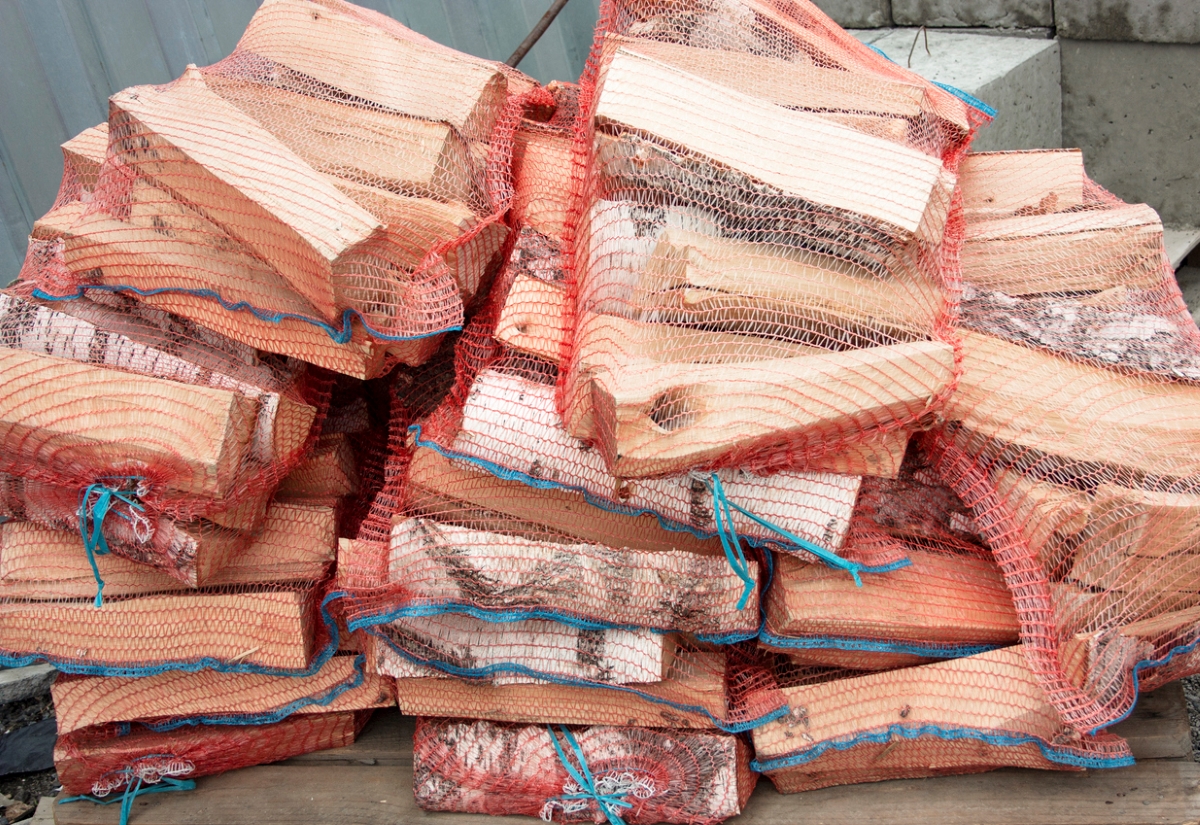
Wood marked as “kiln-dried” has been dried in a kiln instead of in the open air. The purpose of kiln-drying is to remove moisture from wood, which results in a cleaner, longer burn. The goal of heat-treating, on the other hand, is to kill pests and pathogens on the wood. When shopping for high-quality, long-burning firewood, look for kiln-dried, not heat-treated.
If, however, you need to move firewood around—say, you’re transporting wood from your home to your winter cabin—heat treatment matters. Products labeled “heat-treated firewood” have been heated to a core temperature for a specified time (typically 60 minutes at 140 degrees Fahrenheit), with the express goal of killing pests and pathogens. Such wood is generally safe to move, especially if it has a USDA APHIS (Animal and Plant Health Inspection Service) certification label. While kiln-drying does remove some pests, molds, and mildews, according to the American Firewood Producers and Distributors Association (AFPDA), variations in the drying process make it risky to move kiln-dried wood.
Recommended Wood Species for Indoor Fireplaces
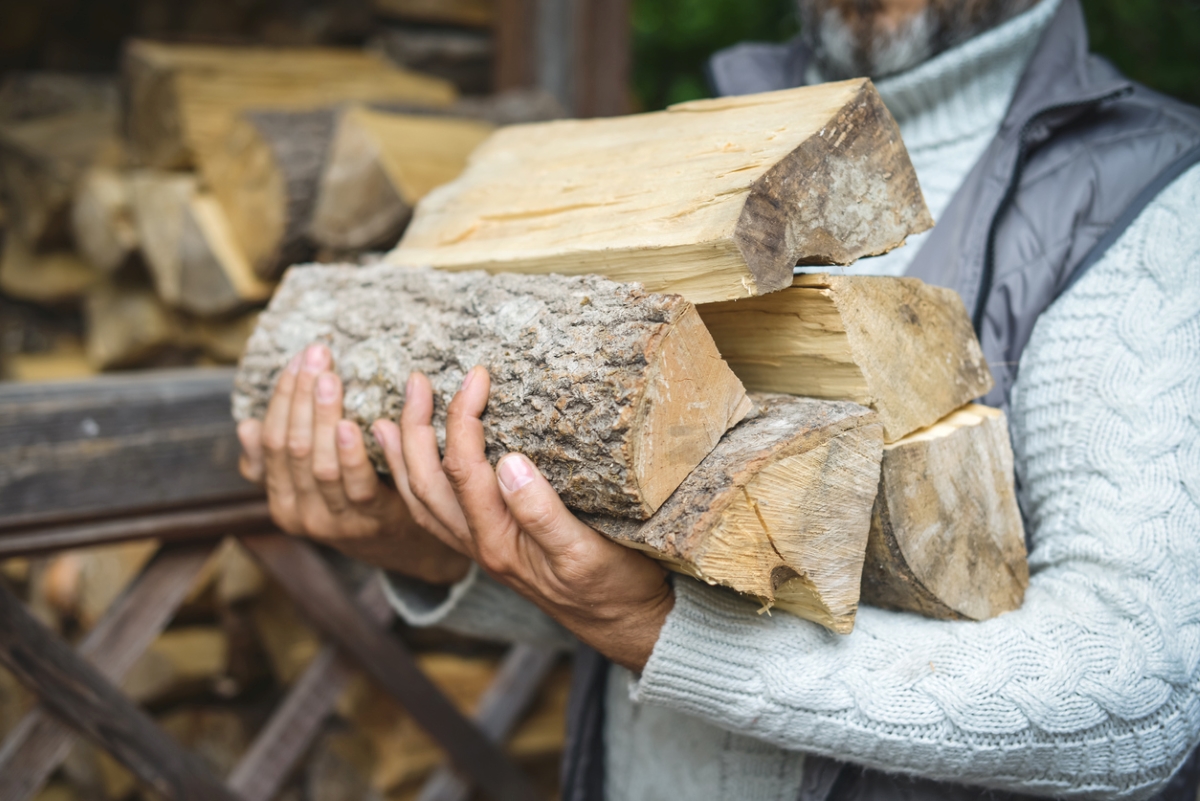
Wood from different types of trees produces different amounts of firewood heat energy, and this energy is measured in British Thermal Units (BTUs). One BTU is the amount of energy required to raise the temperature of 1 pound of water by 1 degree Fahrenheit. Types of wood that release higher BTUs per volume will produce more heat.
While a wood-burning stove or fireplace will probably not be your only source of heat in a room, from a practical standpoint it’s still a good idea to invest in wood with a higher BTU rating. For a sense of scale, an electric heater takes roughly 20 BTUs to warm a square foot of living area, which equates to 8,000 BTUs for a 400-square-foot room. However, wood heat BTU ratings are generally given per standard cord, not per pound or per use. That said, according to Oregon State University, “all firewood dried to the same moisture content contains approximately the same heating value per pound,” which is roughly 8,000 to 9,500 BTUs per pound for the driest woods and 6,500 to 7,500 BTUs for air-seasoned wood with about 20 percent moisture content. So, a pound of the driest wood of any species should heat up that 400-square-foot room. OSU offers a handy comparison of common firewoods, some of which, when used in wood stoves, cost less per million BTUs than electric or gas heat.
In addition to BTUs, consider other factors, including how long it takes to ignite, how long and how cleanly it burns, and whether it is available from local sources. Another consideration is coaling quality, which is a wood’s ability to turn into a bed of hot coal that can provide heat throughout a fire’s burn. Coaling ability generally correlates with wood density.
1. Oak: Dense and High Energy
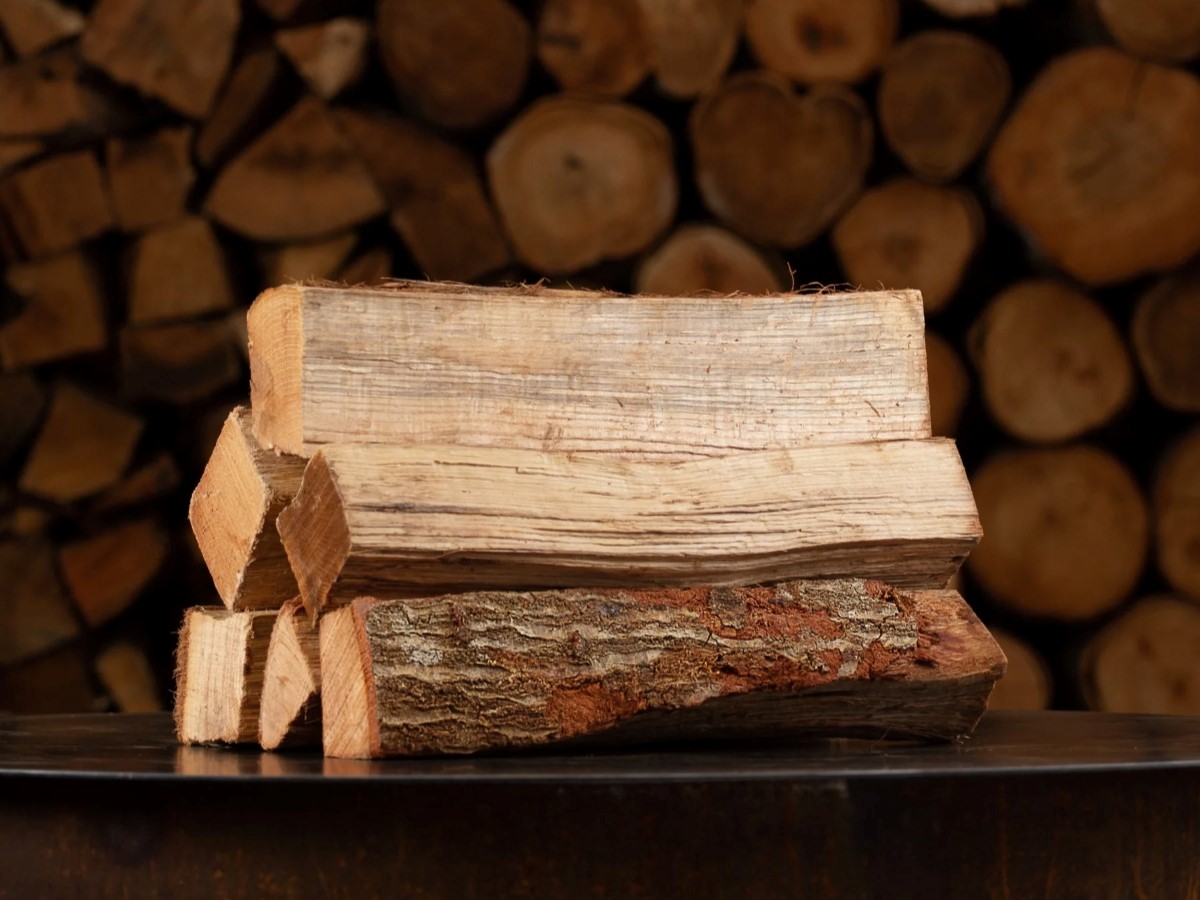
Depending on the subspecies, a cord of oak can produce 21 to 26 million BTUs. Oak logs have excellent coaling quality, and they burn with a low flame and create a steady, hot fire. Red oak is also easy to split and produces a lower amount of heavy smoke than some woods. Freshly cut oak can take a year or two to dry, so make sure you are buying fully seasoned logs. Check for indications of dryness like radial cracks, dullness of color and smell, and loose bark.
Like all hardwoods, oak trees take much longer to grow than pine or birch; they also reproduce slowly. Many old-growth forests are endangered, so ensure that the wood is sourced sustainably by checking for a Forest Stewardship Council certification, which provides forest management standards internationally and in the U.S.
2. Ash: Long Burning, Low Smoke
Ash has an easy-to-split grain, low smoke levels, and a long-lasting burn. Depending on the type, ash tends to produce between 19.1 and 23.6 million BTUs per cord. Ash is harder to source than oak, so contact a local supplier and ask whether they include ash in their mixed-wood cords, and how much it costs. Complement ash with other hardwoods, like ironwood, elm, hickory, oak, maple, walnut, and beech.
The low moisture content of ash means it doesn’t require a long drying time, and seasoned ash is still the safest and longest-lasting choice for an indoor fire. Seasoned logs smoke less and form less creosote. When buying logs, look for gray, dusty bark and lighter, whitish wood.
3. Douglas Fir: Fast-Growing Softwood
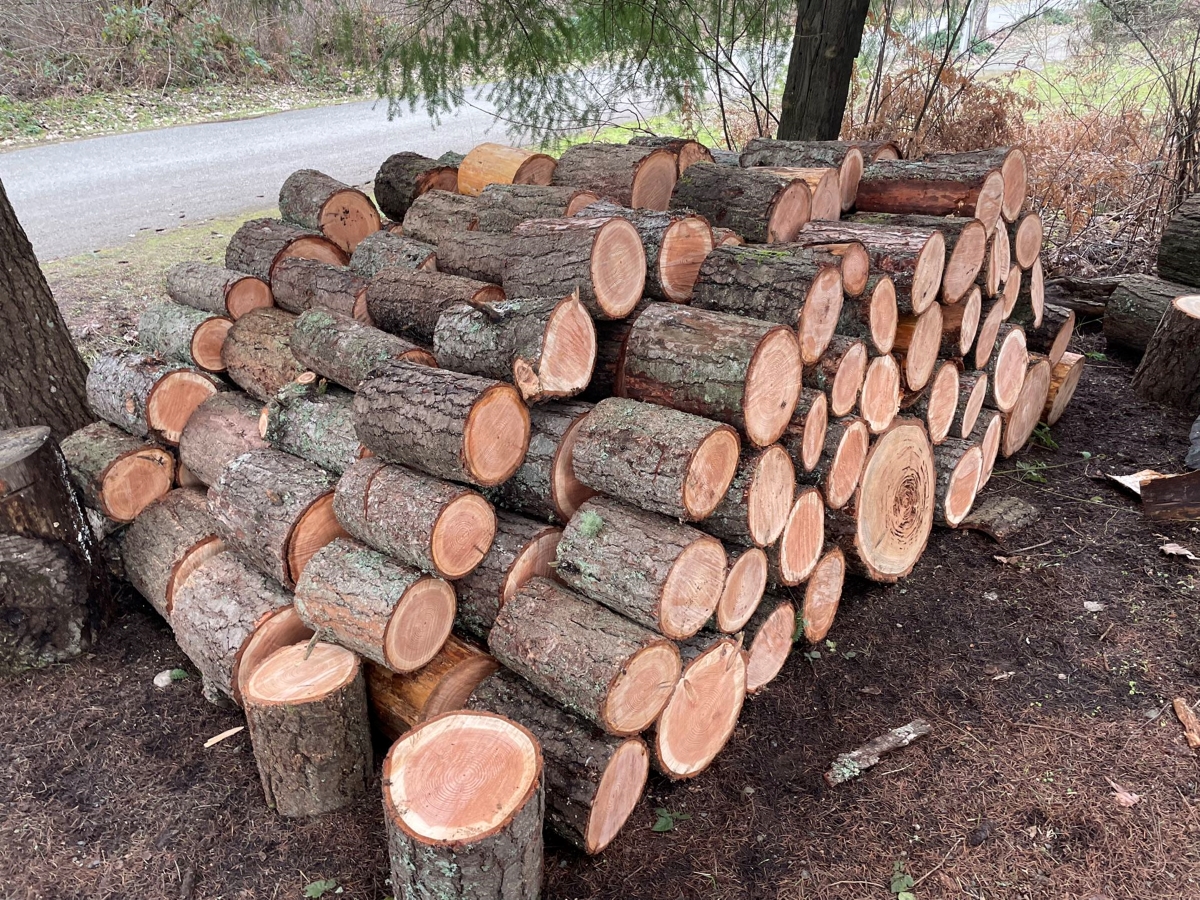
Douglas firs are fast growers, which makes them a favorite choice for reforestation efforts—and for sustainably sourced firewood. Douglas fir is also a high-energy softwood that is easy to ignite and splits easily. A cord of fir produces up to 26 million BTUs, and the wood creates a moderate, steady heat. Because it grows quickly, fir tends to fall in the low to middle range in terms of heat released per cord. It is an excellent choice year-round, and during the holidays, nothing beats its mild, evergreen scent.
4. Fruitwoods: Hot, Fragrant Fires
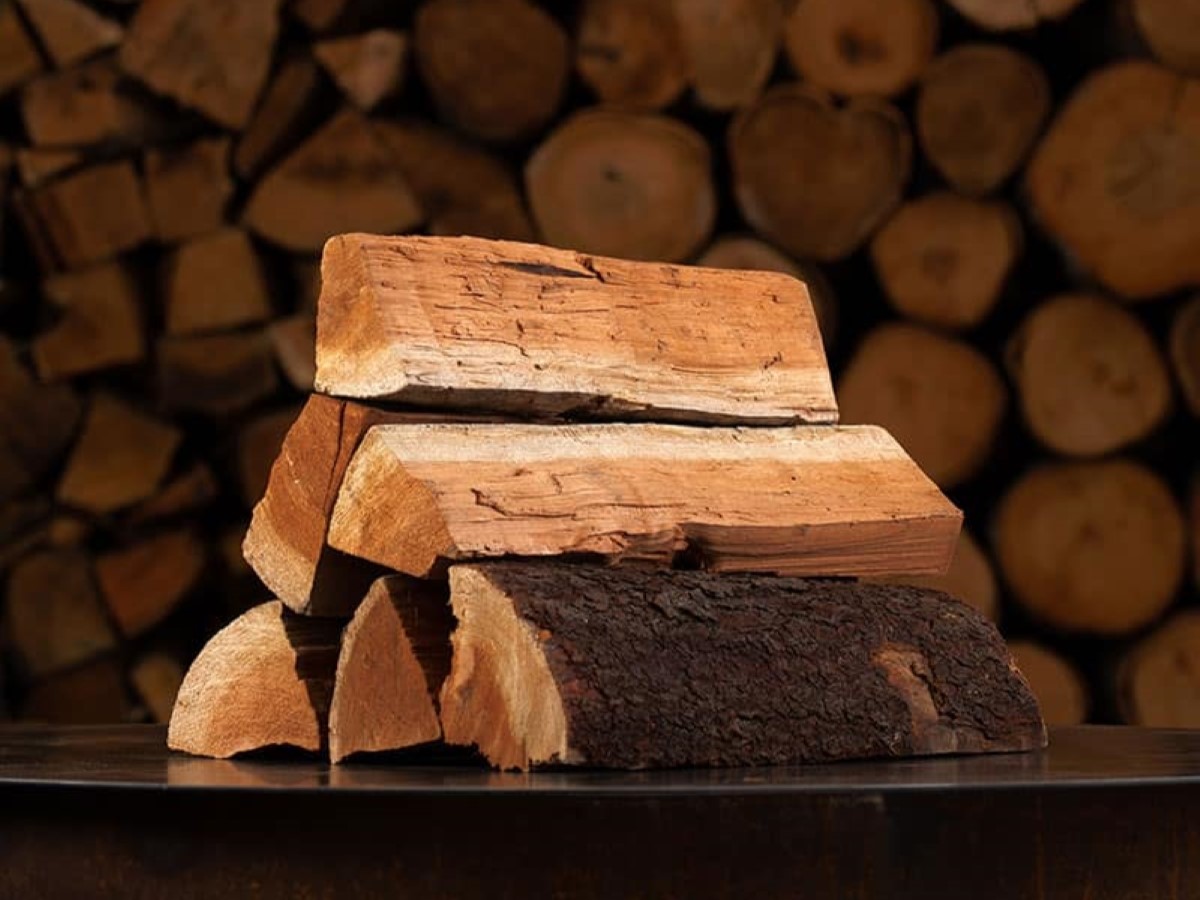
The fruit hardwoods generate low flames and high temperatures, with an energy content that ranges from 20 to 27 million BTUs per cord. Fruitwoods are excellent for home fireplaces, as well as outdoor pits, grills, and smokers. Applewood is slightly dense and more difficult to split than softwoods, but its fires are especially noteworthy for their scent. Applewood has a heat value comparable to ash and oak, and it produces low levels of smoke if seasoned correctly. Cherry has a medium heat value.
Apple, cherry, and pear are considered specialty woods and are used primarily for cooking or smoking, or for occasions like a dinner party or holiday. Because fruit trees rarely grow in abundance in the wild, commercial orchards are the primary source of fruitwoods, so their main downside is price: At press time, an 11-pound box of J.C.’s Smoking Wood Sticks was selling for $43.99. Consider contacting a local orchard or firewood supplier, especially if you want to use fruitwood for heat, not only grilling.
5. Birch: Attractive Logs and Flames
Birch is a northern tree species that is used by many people to keep warm in milder weather or winter. Birch is hard and has a fairly high energy content—about 18 to 21 million BTUs per cord—comparable with species like walnut and cherry. Birch fires give off beautiful blue flames, and the logs themselves are decorative, with silvery bark that can complement your home decor.
Depending on whether you use black, yellow, or white birch, burn times and heat levels will vary, but in general, birch burns more quickly than hardwoods like elm and oak. It is considered a low smoke producer and easy to split. For woods like birch, the curing process to dryness can take at least 3 to 6 months.
6 Types of Wood You Should Never Burn Indoors
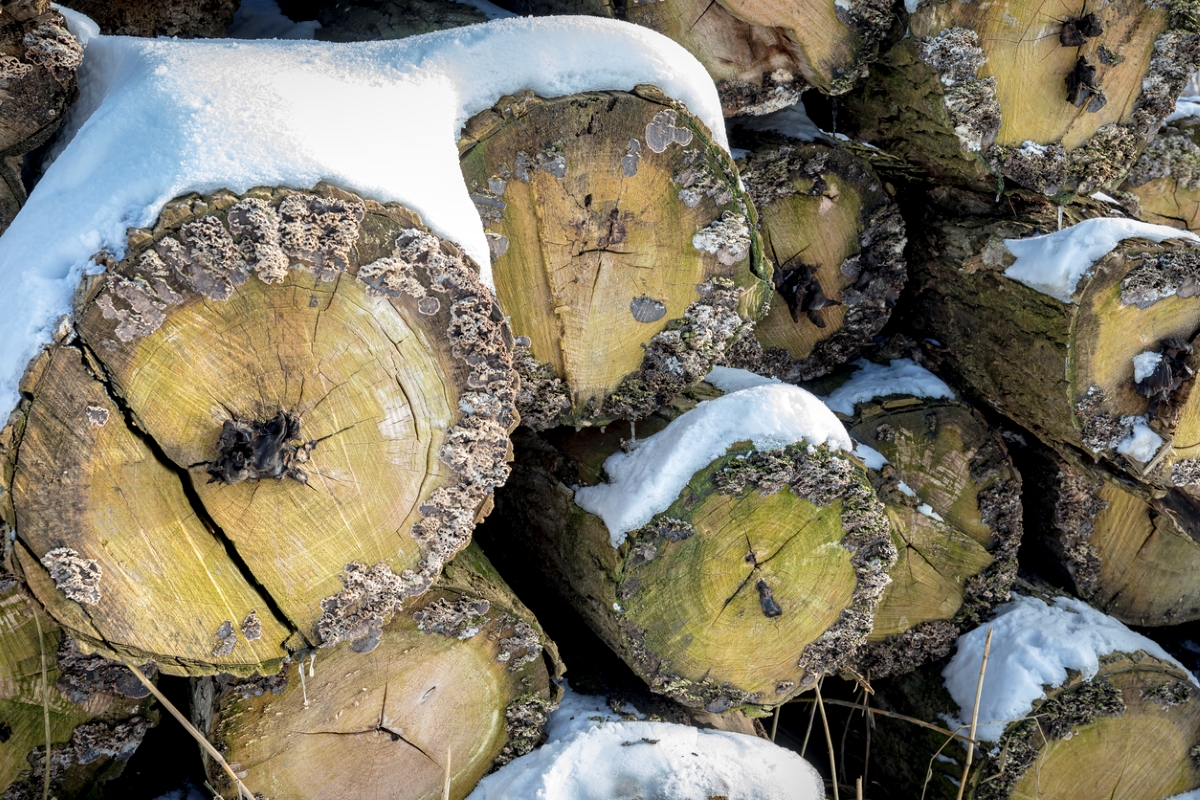
Some types of wood are not safe or appropriate to use indoors. These woods may release unhealthy pollution, or their burn value may simply be too low to justify the amount of gases they produce. As already discussed, wood that isn’t properly seasoned burns cooler, releases more smoke, and contributes to creosote buildup.
But in addition to improperly seasoned wood, avoid burning logs that are too large: An unsplit log that measures more than about 5 inches or so in diameter will take too long to burn, and the burning temperature will go down. The unburned fuel gases will then travel up the chimney and into the atmosphere. The result? Unnecessary pollution and a weaker fire.
Beyond ensuring that wood is properly seasoned and appropriately split, avoid burning these types of wood indoors, which can release allergens or toxic particles into the air.
- Moldy or rotted wood
- Green wood
- Driftwood
- Poisonous wood (poison oak, poison ivy, or sumac)
- Pressure-treated wood
- Oleander
RELATED: The Best Fire Logs for Long-Lasting Ambience, Tested
Tips for Buying, Burning, and Storing Firewood
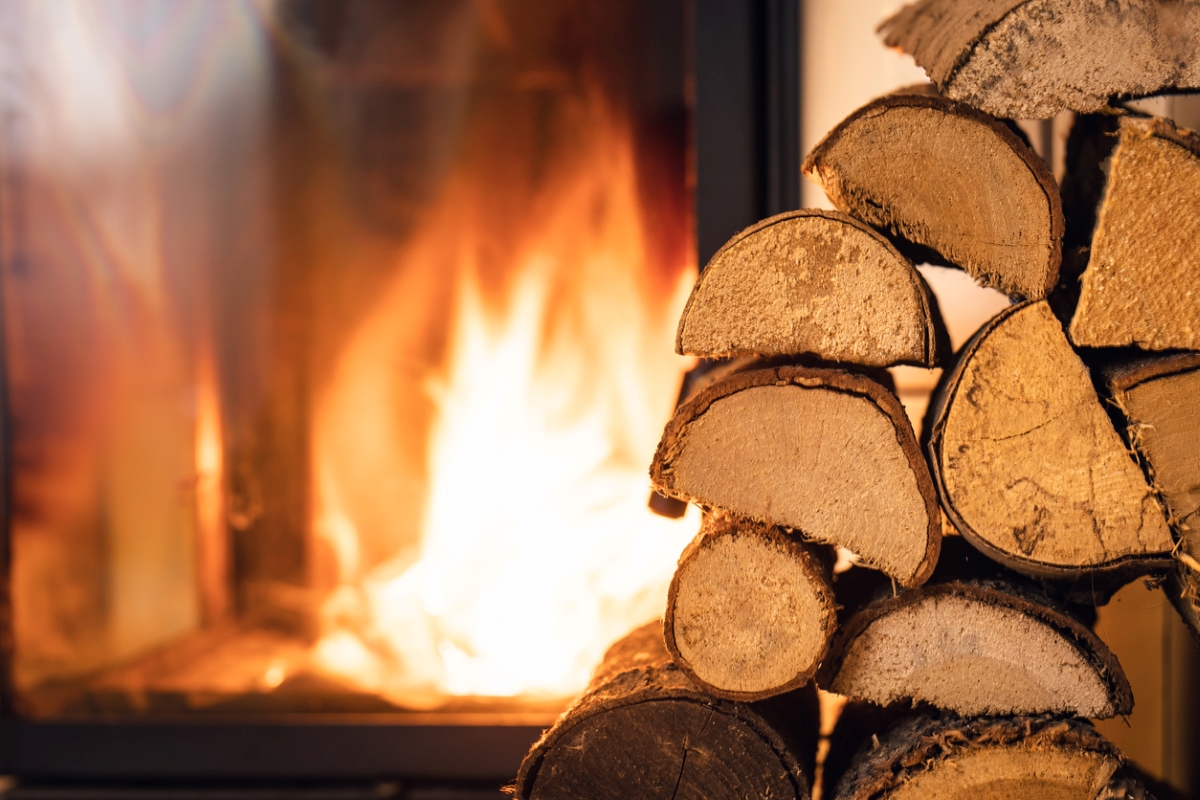
Whenever you’re burning firewood, but especially when burning wood indoors, always keep safety top of mind. The following tips will help you purchase, store, and burn wood for your home’s fireplace as safely and efficiently as possible.
Buy local.
In general, wood is considered “local” if it’s sourced within about 10 to 15 miles of your home, although distances of up to 50 miles might be safe if there is no closer source. Buying locally helps save money on transportation costs, but it’s especially critical for preventing environmental damage. Do some research before you buy: Ask colleagues and neighbors where they purchase wood. If you live in one of the 13 states that participate in Firewood Scout, consult their listing for local providers. Check state and local information regarding licensing of wood sources. If you can’t buy locally, look for sources of heat-treated wood, which should be free of pests.
Balance burn time against creosote buildup.
If not regularly cleaned, the walls of your chimney will over time become coated with creosote, the highly flammable, blackish-brown tar residue produced by burning wood. Built-up creosote can restrict airflow through the chimney and create a fire hazard, and creosote fumes and particles can negatively impact your health. While you can reduce the risk of chimney fires by having your chimney professionally cleaned or using a creosote remover, it’s wise to stick with woods like oak and ash that produce a good, long burn while releasing less of the noxious substance.
RELATED: Whatever You Do, Don’t Burn These 15 Things in Your Fireplace
Ignite with softwoods, then add longer-burning hardwood.
Many softwoods like fir, pine, and cedar produce more smoke, and therefore more creosote. That said, these evergreens contain fragrant resins and oils that ignite easily and are perfect for kindling. If you don’t keep softwoods around, try a commercial brand like Fatwood Fire-Starter from Plow & Hearth.
Balance those easy igniters with harder woods like oak, ash, and beech, which will burn longer and cleaner.
Burn only properly seasoned wood.
Freshly cut green logs produce more smoke, which makes them more hazardous to burn, especially indoors. For more efficient and cleaner burning, make sure that any wood you use is properly seasoned. Wood purchased from a supplier should arrive fully seasoned and ready to use, but if you cut your own wood, remember it can take 6 months to 2 years to fully dry, depending on the species.
Purchase firewood well ahead of the winter rush.
There is no fixed cost for firewood; prices fluctuate according to market factors, including weather, supply, and demand. A cord is the standard unit of measurement for firewood and is equal to 128 cubic feet. Some suppliers also sell smaller quantities called “face cords.” The volume of a face cord varies by supplier, but it can range anywhere from one-third to one-half of a cord. In 2023, the average full cord of wood ranged between $275 and $400.
Be mindful of state laws and guidelines for buying firewood.
Don’t Move Firewood provides a map with links to state-specific regulations, including information about common pests and diseases and banned woods and practices. You can also check the USDA Plants Database to make sure you are not accidentally buying an endangered species.
Store wood safely outdoors.
Stack wood outdoors in the sun, at least 20 feet from the house, especially in fire-prone areas. Stacked wood also attracts critters like termites, which is another excellent reason to avoid placing wood up against the house. To keep wood dry, cover it when possible, but also allow for airflow around the stack. Ideally, elevate the stack slightly on a firewood rack or use some other means to keep it off the ground. Stack naturally seasoned wood bark-side down to help water evaporate from the logs. Stack kiln-dried firewood bark side up.
Limit the amount of firewood you keep indoors.
Keep a small stack of ready or split wood in an indoor spot like the garage or a shed to keep it dry and ready for use, especially when rain or snow is in the forecast. Store only dry wood indoors, and choose a location with low humidity and good airflow. Limit the stack to a few days’ worth, and follow many of the same practices used for outdoor storage: Stack in rows, ensure airflow around the stack, and keep wood away from any heat sources. Use a rack, if possible, to prevent the stacked wood from toppling over and injuring anyone.
In general, kiln-dried or heat-treated firewood is safer to bring indoors, since the process should have eliminated pests.
RELATED: How To: Stack Firewood
Final Thoughts
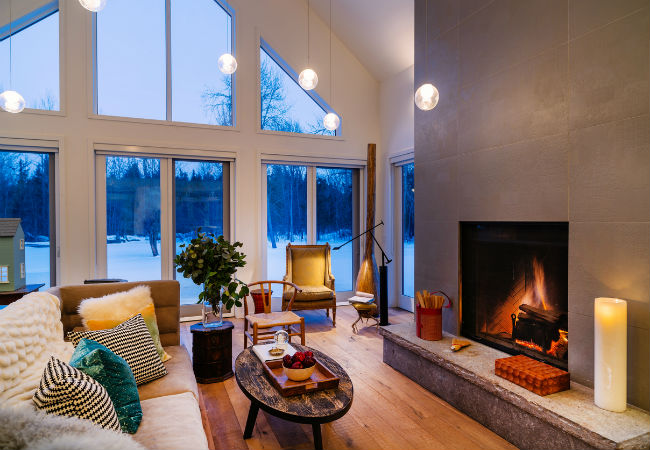
Burning wood in a home’s fireplace evokes a warm, cozy atmosphere, but to keep the experience as safe and comfortable as possible, it’s crucial to choose the right firewood. Aim for an affordable wood that has been properly dried, or “seasoned,” so it will burn long, hot, and cleanly. Firewood is the ultimate “buy local” product. If possible, it’s best to stick with wood from trees within 15 miles of your location to make sure you’re not importing novel pests and diseases to local trees. Another option is to purchase heat-treated or kiln-dried wood from a reputable source. Finally, store your wood properly to make sure it stays dry, pest-free, and ready for use.
Even when burning clean, local wood, good fireplace maintenance is essential. Wood-burning fireplaces should be inspected each fall before burning begins and cleaned annually, along with the chimney, as a DIY task or by hiring a professional.

